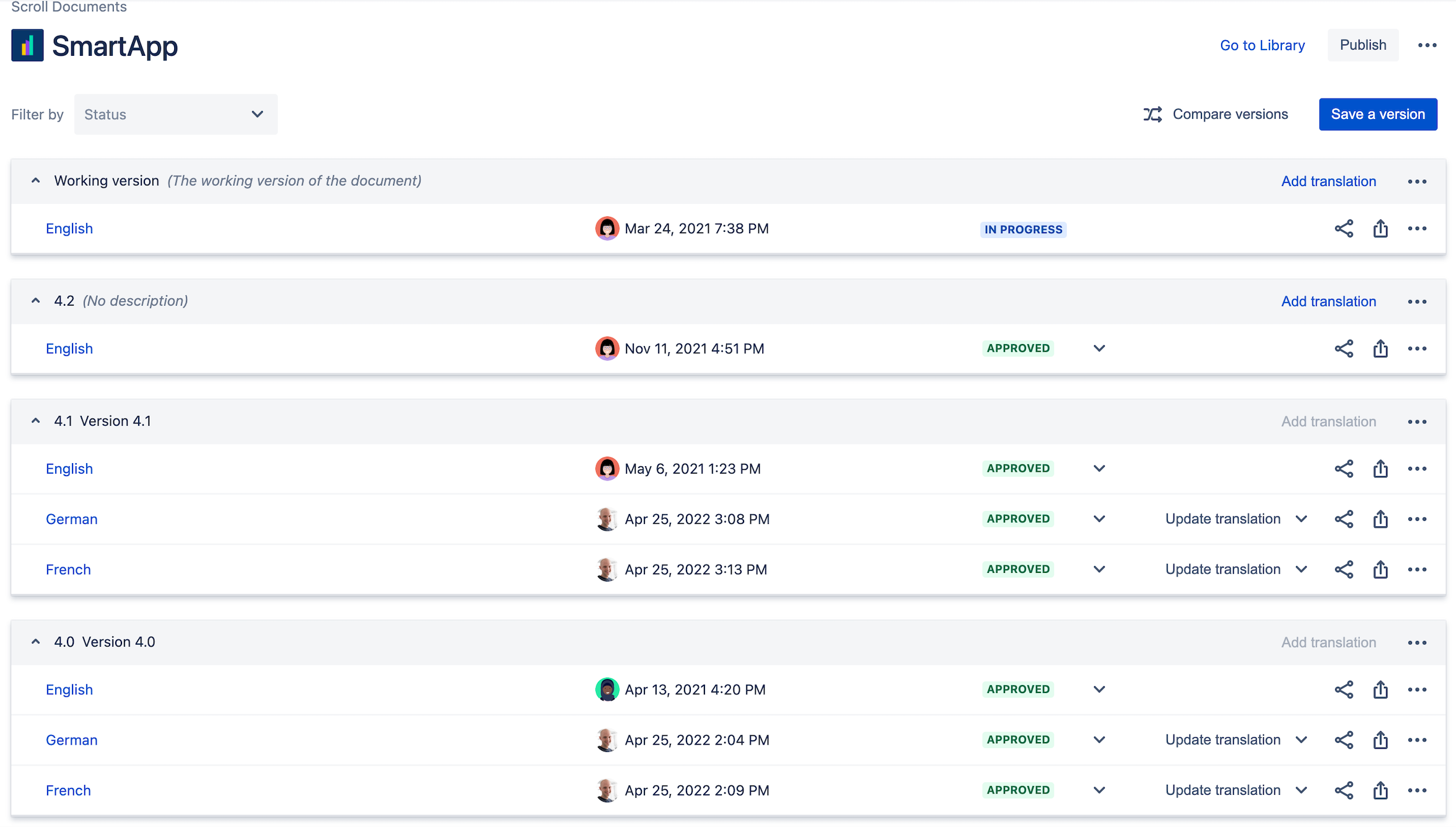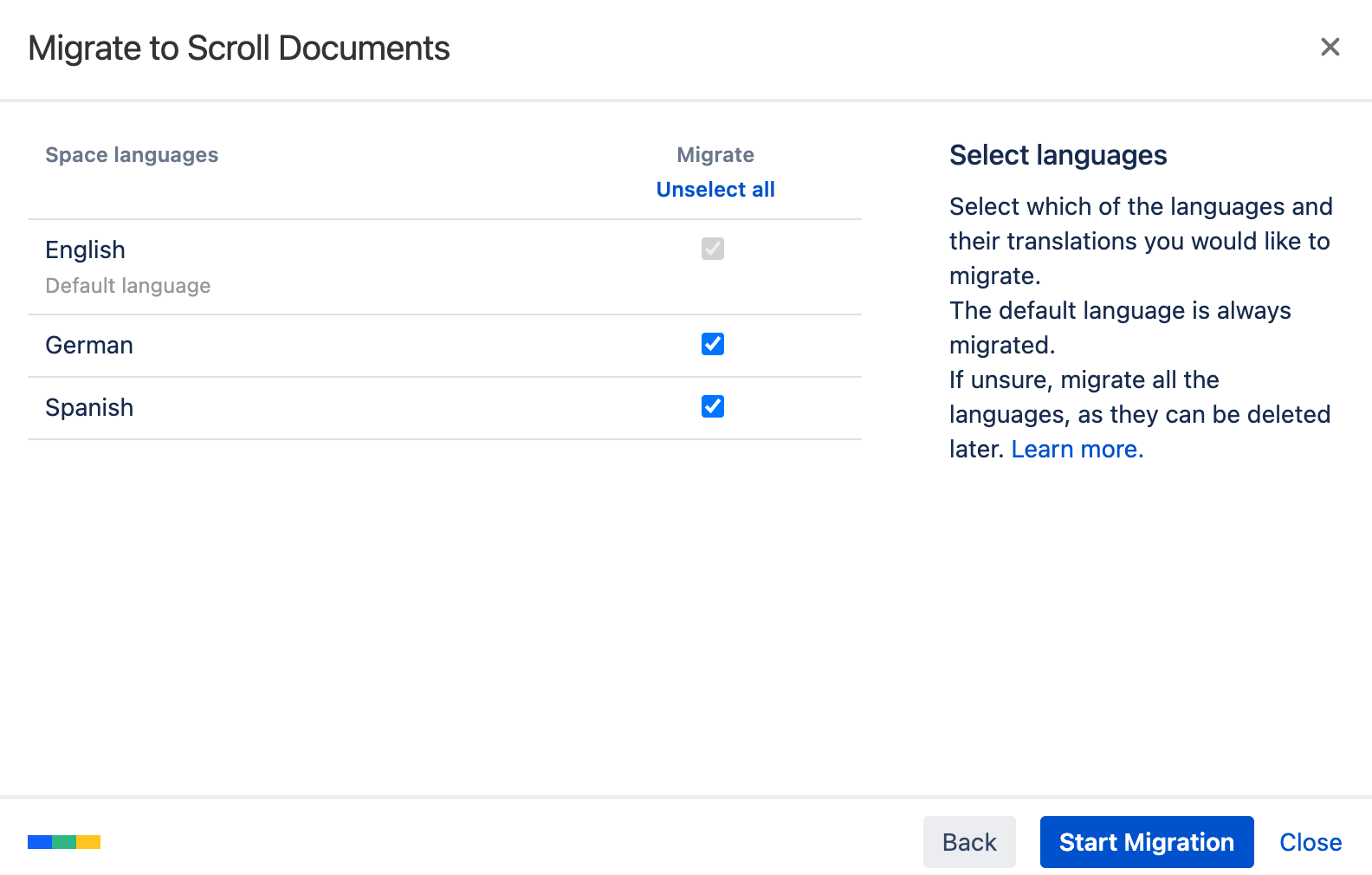We’re excited to announce the release of another major feature for our Cloud Scroll App suite – Translations for Scroll Documents! In this article, we’ll give you a quick summary of how translation management works on Cloud and what will change for migrating Server users.
Translations for Scroll Documents – Another Extension App
Following the variants extension app, Translations for Scroll Documents comes with many of the same changes. For example, Translations for Scroll Documents is also an extension app for Cloud and Data Center that requires Scroll Documents to run. With this out of the way, let’s have a look at the feature changes.
Translate Individual Versions
As with all functionality we bring to Cloud, changes needed to be made both for technical and usability reasons. The most notable change about creating translations with Scroll Documents is that they are no longer scoped to the entire space or even document. Instead, the document version is the standard scope for translations – allowing for versions to be translated independently:

Of course, you don’t need to re-translate any content that has stayed the same between versions, as we provide an option to “keep“ still current translations from older versions.
External XLIFF Translations on Cloud
Support for external translation using the XLIFF export and import – well-known from our Scroll Apps on Server – returns in Translations for Scroll Documents, enabling users to collaborate with translations agencies on Confluence Cloud.
Not much has changed about the XLIFF feature itself – content is exported, submitted for translation and re-imported into Confluence. Feel free to give it a try! If you have any feedback, we’re happy to hear it – let us know under help@k15t.com!
Changes Under The Hood
In addition to the points mentioned above, there are some minor technical changes that may have great consequences for some users, the most impactful being:
-
Dedicated Confluence pages for translated content: On Server, all languages shared one physical Confluence page, which greatly affected the ability to link to or search for translated pages, or use some native or third-party macros. Within Scroll Documents, translations get their own page tree, which makes working with them easier and more predictable.
-
Authoring language is more flexible: The concept of the authoring language is less pronounced in Scroll Documents than the default language on Server. XLIFF exports can now use additional languages as the source, allowing for more flexibility when translating into multiple languages.
-
Translation status labels: In order to make use of native Confluence functionality, translation statuses are now tracked with the page labels translated or needs-translating . Labels are generally more familiar than newly introduced concepts, and can also be used in many ways to query or report on pages in Confluence.
Migrate Translations to Scroll Documents
In our effort to enable every Scroll App user’s migration to Confluence Cloud, we’re committed to providing not only new features, but also migration paths. The release of Scroll Translations 4.3 extends the migration tool previously known from Scroll Versions to also migrate different languages:

While the unified migration path for Scroll Translations and Scroll Versions is rather straightforward, here are some things that current Scroll Translations users should be aware of:
-
All versions will be translated: As languages are space-wide in Scroll Translations, all of the versions will be translated in the migrated document, including the Working version. If you’re authoring both versioned and translated docs, we recommend removing the Working version translation and only translate saved versions.
-
Updating translations: With the separation of page trees mentioned above, new pages are no longer automatically created in all languages. Instead, Synchronize pages – a new action in the Document manager – updates both the page tree and the status labels. Learn more.
Atlassian Cloud & Migration News
-
Orderly Databases for Confluence is K15t’s latest addition to the Cloud Marketplace and revolutionizes tables in Confluence Cloud by storing them in a database within your space, enabling you to easily filter, query or embed both data points and entire tables. This vastly improves any setups using page properties or large tables in Confluence. Here are a few ways your team can put this app to good use, from managing your content backlog to creating an employee database. It’s also free for up to 10 users! So give it a try.
-
Scroll HTML Export for Confluence Cloud has been in the works for the past few months and we’re preparing for a public Marketplace release in the upcoming weeks. Just watch this Jira issue to be notified once the app is available!
-
Scroll Viewport for Confluence Cloud is the poster child of our Scroll Apps and has seen a lot of awesome improvements in the past few months. The highlights include Scroll ImageMap and Variants support for Help Centers, fully customizable URLs and improved support for custom CSS and Javascript. An integration with Translations for Scroll Documents in under way!
